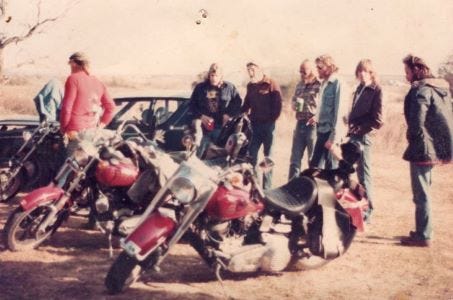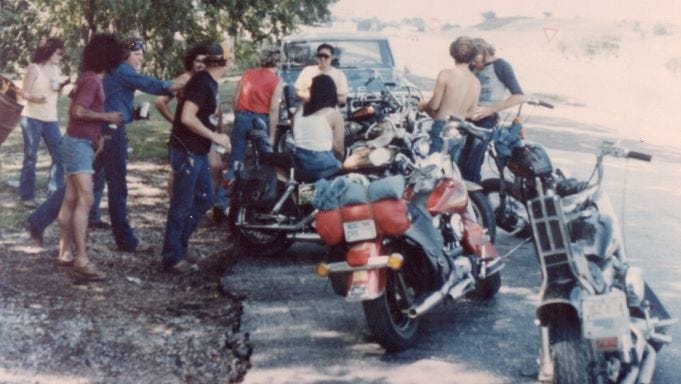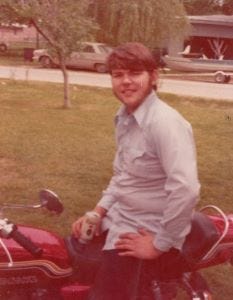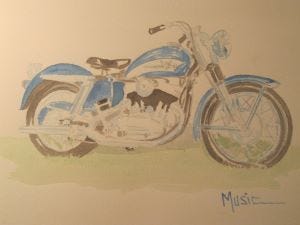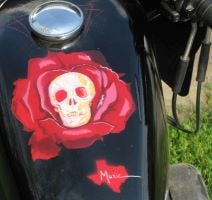Sometimes.
I like to watch just about all of them because I love motorcycles and enjoy seeing them on screen or in person, especially if they are rare or classic models. The 60s biker flicks never did let a plot get in the way of senseless violence or over-the-top acting, but they featured a lot of classic and custom two-wheelers.
The Wild One from the early 50s and Easy Rider from the late 60s are no doubt the best known of the genre, though in my opinion, neither expressed the true soul of riding. Capturing and expressing on celluloid the emotional experience of riding has to be a daunting task. In fact, there is an old saying among bikers, “If I have to explain, you’d never understand.” Easy Rider with its panoramic riding sequences filmed in open country came close, but in reality, the movie was more about the Hippie movement than about bikers. The character Chino played by Lee Marvin in The Wild One, a cigar smoking brawler with a road-worn Harley and bumblebee jersey by far symbolized a grassroots biker better than the star Marlon Brando or the club members, who were decked out in designer leathers and spoke like jazz musicians from a San Francisco coffee house.
Speaking of bumblebee sweaters, I’d love to have one. If anyone knows where to find them, please let me know.
I started riding when motorcycles were all kick starters. I bought my first Harley in 1982, and to this day … after thousands of times … when I start my current ride, it’s almost euphoric. The tug of the handlebars while accelerating through the gears and the vibration and the roar of the engine release a shot of adrenaline that is as addictive as a narcotic, and makes the swallowed bugs, rain, heat and cold, and the dodging of distracted drivers of little significance. It’s internal, almost spiritual, and recognizable to other riders, which results in comradery among bikers who call it “in the wind.”
But how do you convey that on the big screen?
Mostly it doesn’t happen. I suppose cowboys think the same about rodeo movies. It may be entertaining, with all the ups and downs (bad pun) of the harsh sport, but something is missing.
Some come close. I recently saw the movie The Loveless, released in 1981 with a young Willem Dafoe as the lead player. It revolves around a small group of late 50s bikers headed to Daytona, home to the traditional biker gathering that draws huge numbers of riders from all over. One of the bikes breaks down and they talk a local garage owner in a small community into letting them use his shop to make repairs, a fairly normal occurrence. People are generally accommodating to traveling motorcyclists. While awaiting arrival of the needed parts, the riders experience some peculiar interactions with the locals.
The settings, cars, buildings, and most importantly the motorcycles are period correct. The actors’ dress and mannerisms reflect this, as well. People dropping dimes into coke machines and drinking from heavy glass bottles, talking on payphones, and smoking cigarettes from vending machines unlocked a well of nostalgia.
One thing that stood out was that virtually everyone in the movie had a sob story. The bikers had met in prison. The locals all appeared to have some overwhelming tragedy eating at their lives. The thing is bikers on a run are generally in a festive mood. The past and future are abstractions. The moment, the now, is all that counts. Even mechanical problems or bad weather are insufficient to dampen spirits. “Upbeat” was totally scrubbed in this movie. There was a scene in the garage while the bikers were wrenching on the ailing scooter where jocularity briefly surfaced. But for the most part, the characters were emotionally cold. Even senseless deaths towards the end failed to raise any sympathy or concern, for that matter. They really were “the loveless.”
I was surprised I’d never heard of the movie before, though it is considered a cult classic. I try to keep an eye out for biker-related themes but completely missed this one. The 80s was a transition period for the biker lifestyle as a whole. When The Loveless was released in 1981, the biker scene was still primarily a working-class realm and not yet fully embraced by white collar professionals, or rich urban bikers (RUBS.) I wrote about this recently here. Had the movie been released a few years later, the impact might have been more substantial. I would definitely recommend the film if you’re into biker nostalgia.
Another movie I checked out was The Bikeriders. Released in 2024, it revolves around a club in Chicago. I’d seen a preview at a theatre and wasn’t impressed. It showed guys riding without glasses or any eye protection at all. This drives me nuts. Nobody purposely rides a motorcycle more than a mile without glasses. I once shattered my goggles and rode thirty miles home with no protection. I had to stop and wash a gnat out of my eye with muddy ditch water. If you search my motorcycle now, you’ll find extra goggles as well as glasses, with shades for day and clear for night. I won’t make that mistake again.
However, I came across The Bikeriders again on the internet and decided to watch and was surprised that the plot was true to form. The club was formed by a group of friends who raced dirt bikes and were street riders as well. Their leisure time was spent making weekend runs and throwing parties, with their business meetings held at a local bar, which is usually how clubs come to be. However, over the objections of the club president additional chapters were formed, and this is where things went sour.
Minor incidents among bikers are not unheard of. Imagine a group of young men with a full tank of high-octane testosterone and a long-legged girl in Daisy Duke shorts. What could go wrong? Or right, depending on your point of view. Unfortunately, the biking scene does draw a jughead or two. The shooting at Twin Peaks outside of Waco several years ago is a prime example. In my opinion, the incident was a collaborated federal and state false flag aimed at disrupting a political movement that had been holding meetings for decades without any violence. One theory is that a club of misfits was formed solely for this purpose, men who from what I can discern obtained their knowledge of bikers by watching Sons of Anarchy reruns. One of the offenders was in his forties and his family claimed (according to a report of which there were many that conflicted with one another) he’d never had a motorcycle until he joined the club. “Duh, let me do it, boss, I always wanted to be a big, tough biker.”
Not a bad movie. The Bikeriders did accurately portray many aspects of the Harley scene.
Check it out and you’ll get to see some really nice bikes, which to me is what it’s all about.
End




